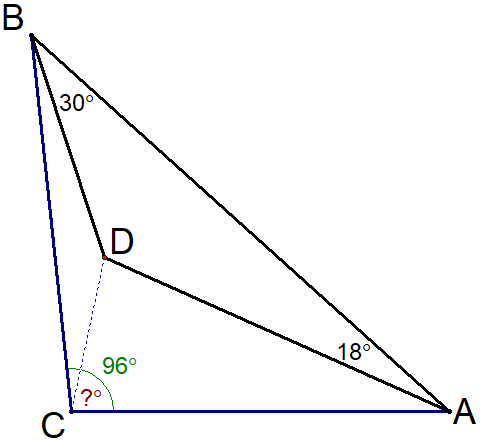Find the measure of angle
△ A B C has sides A C = B C and ∠ A C B = 9 6 ∘ . D is a point in △ A B C such that ∠ D A B = 1 8 ∘ and ∠ D B A = 3 0 ∘ . What is the measure (in degrees) of ∠ A C D ?
The answer is 78.
This section requires Javascript.
You are seeing this because something didn't load right. We suggest you, (a) try
refreshing the page, (b) enabling javascript if it is disabled on your browser and,
finally, (c)
loading the
non-javascript version of this page
. We're sorry about the hassle.
2 solutions
Aly, feel free to take this image and add it to your problem.

Since △ A B C is isosceles ∠ A B C = ∠ B A C = 4 2 and we can easily derive ∠ D A C = 2 4 and ∠ A D B = 1 3 2
For simplicity let A C = B C = 1 then by the law of sines on △ A C B , A B = sin 4 2 sin 9 6 = sin 4 2 sin 8 4 = sin 4 2 2 sin 4 2 cos 4 2 = 2 cos 4 2 = 2 sin 4 8 .
Now using the law of sines on △ A D B , sin 3 0 A D = sin 1 3 2 2 sin 4 8 , A D = sin 1 3 2 sin 4 8 = sin 4 8 sin 4 8 = 1
So △ A D C is isosceles. ∠ D A C = 4 2 − 1 8 = 2 4 and ∠ A C D = 2 1 8 0 − 2 4 = 7 8
⎩ ⎪ ⎨ ⎪ ⎧ C D A C = sin ∠ C A D sin ∠ A D C C D B C = sin ∠ C B D sin ∠ A D B .
Since A C = B C , we have:
sin ∠ C A D sin ∠ A D C sin 2 4 ∘ sin θ 2 sin θ sin 3 0 ∘ sin θ sin θ ⟹ θ = sin ∠ C B D sin ∠ A D B = sin 1 2 ∘ sin ( 2 2 8 ∘ − θ ) = cos 1 2 ∘ sin ( θ − 4 8 ∘ ) = sin 7 8 ∘ sin ( θ − 4 8 ∘ ) = sin 7 8 ∘ = 7 8 ∘ Note that sin ( 2 x ) = 2 sin x cos x Since sin ( 1 8 0 ∘ − x ) = sin x Assuming θ − 4 8 ∘ = 3 0 ∘ ⟹ θ = 7 8 ∘ proving that the assumption is correct.
Therefore, ∠ A C D = 1 8 0 ∘ − ∠ C A D − ∠ A D C = 1 8 0 ∘ − 2 4 ∘ − 7 8 ∘ = 7 8 ∘ .